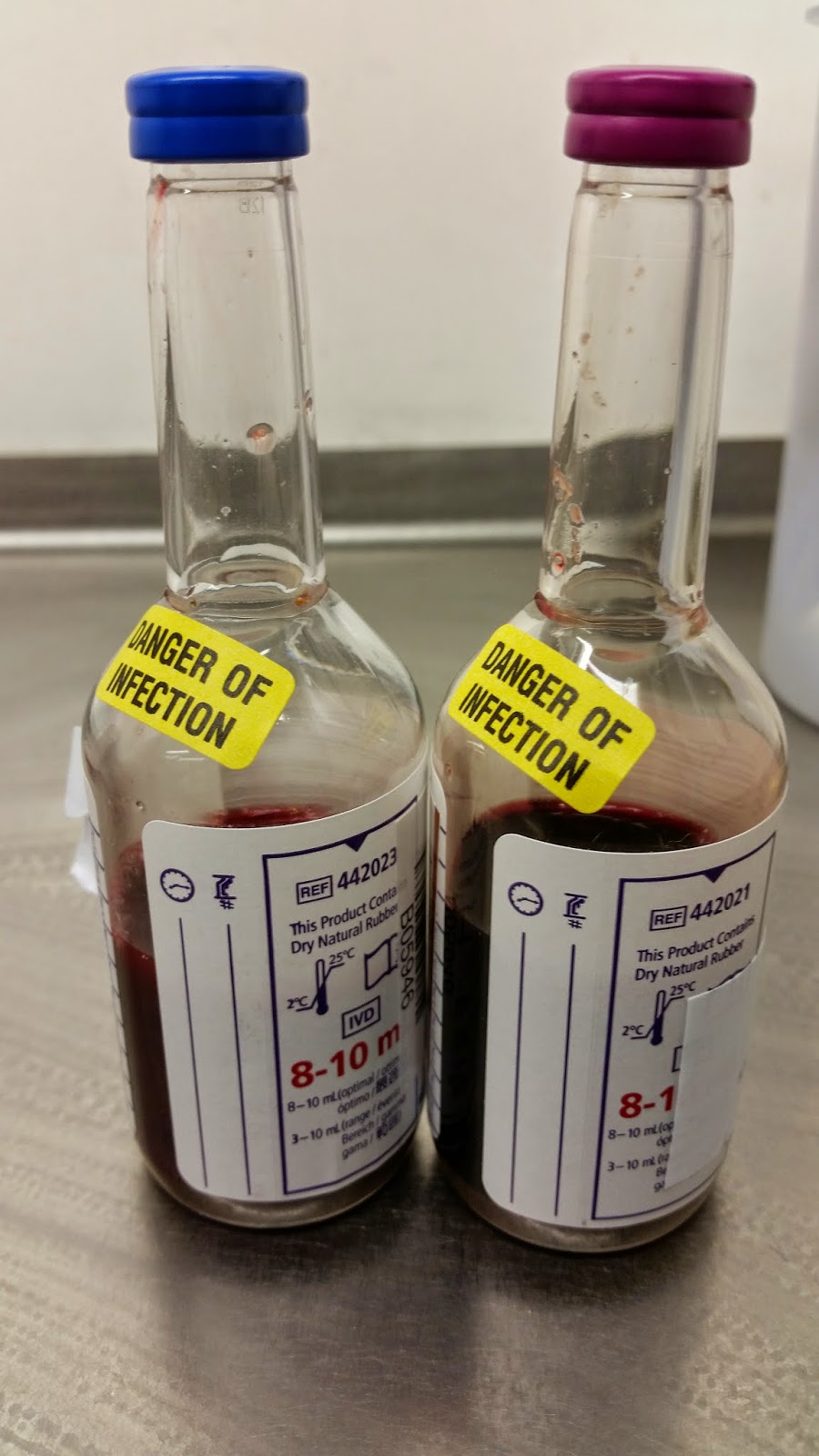Salmonella are predominantly motile (most species except Salmonella
pullorum-gallinarum are motile with peritrichous flagella), non-spore
forming, Gram negative rod bacteria that belongs to Enterobacteriaceae family.
They are divided into two species – Salmonella bongori (previously
serotype V) and Salmonella enterica (Salmonella
enterica is subdivided into subspecies – enteric (serotype
I), salamae (serotype II), arizonae (serotype IIIa),
diarizonae (serotype IIIb), houtenae (serotype IV) and indica (serotype
VI), and over 2500 serovars. The serovars are
defined based on the somatic O (Lipopolysaccharide) and flagellar H antigens
(The Kauffman-White classification).
The blood culture aerobic and anaerobic bottle flagged up positive
after 8 hours incubation in the BD Bactec FX Blood culture analyser and upon
Gram stain shows Gram negative rods. Routine blood culture plates where
inoculated according the Laboratory SOP - Blood agar, chocolate agar, UriSelect
chromogenic agar and FAA AN anaerobic plates. All culture plates were purchased
from E & O Labs (http://www.eolabs.com/).
After 18-48 hours incubation at appropriate temperatures and condition, there
was growth on all plates. The Salmonella isolate on culture
plates are shown below.
Culture medium
|
Incubation condition
|
Incubation Time
|
Appearance
|
Blood
agar
|
CO2 at
37OC
|
18 – 48
hours
|
moist,
grey, round non-haemolytic colony
|
Chocolate
agar
|
CO2 at
37OC
|
18 – 48
hours
|
moist,
grey, round colony
|
UriSelect
chromogenic agar
|
Air at
37OC
|
18 – 24
hours
|
moist,
white/cream, round colony
|
This isolate was then identified using Biomerieux Vitek MS (MALDI-TOF)
as Salmonella group. Purity plates were done on CLED plates
and used for agglutination test after 24 hours incubation at the appropriate
temperature condition. Salmonella isolates are used for
serological confirmation using the agglutination test Polyvalent O and
Polyvalent H specific antisera. This is an easy, quick and straightforward
method. Specialist reference microbiology laboratories use more advanced and
automated methods such as PCR technique.
The Kaufmann-White scheme is a system complex serotyping scheme that
classifies Salmonella into serotypes based on their surface
antigens. Specific antisera are raised against three antigenic sources; the ‘O’
polysaccharide component of the bacterial cell wall, the ‘H’ flagellar antigens
present in most strains and the ‘Vi’ virulence/capsular antigen present mainly,
but not exclusively, in S.typhi. It was further found that each
strain could possess several ‘O’ determinants and so could be attributed to a
particular ‘O’ group. Additional subdivision could also be made on the basis of
flagella ‘H’ antigens as Salmonella exhibit phase variation between motile
(phase 1) and non-motile (phase 2) phenotypes. The Kaufmann-White scheme was
first published in 1934 listing 44 serotypes, but now contains serotypes for
more than 2500 Salmonella spp and is used both in routine and
specialised laboratories for the identification of Salmonella species. Examples
of the serotypes can be seen on the table below
Serotypes
|
‘O’ Antigens
|
‘H’ Antigens
|
|
Phase 1
|
Phase 2
|
||
Salmonella typhi
|
9,12,Vi
|
d
|
None
|
Salmonella paratyphi A
|
1,2,12
|
a
|
None
|
Salmonella
paratyphi A var.
Durazzo
|
2,12
|
a
|
None
|
Salmonella
paratyphi B
|
1,4,5,12
|
b
|
1,2
|
Salmonella
paratyphi B var.
Odense
|
1,4,12
|
b
|
1,2
|
Salmonella enteritidis
|
1,9,12
|
g,m
|
None
|
Salmonella typhimurium
|
1,4,5,12
|
i
|
1,2
|
 |
| Salmonella spp. on blood agar |
 |
| Salmonella spp. Gram negative rods |
 |
| Salmonella spp. Gram negative rods |
 |
| Salmonella spp. on Chocolate agar |
 |
| Salmonella spp. on UriSelect chromogenic agar |


No comments:
Post a Comment